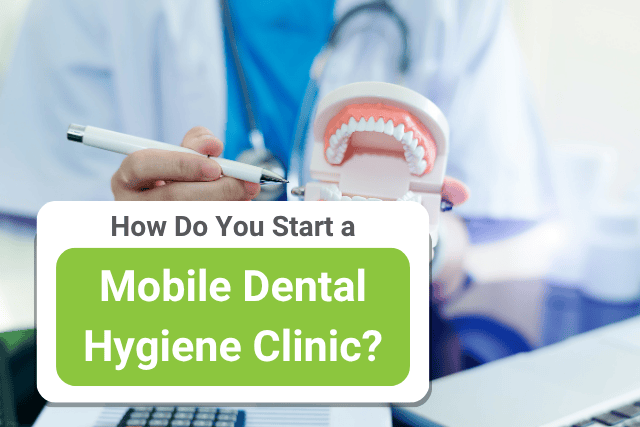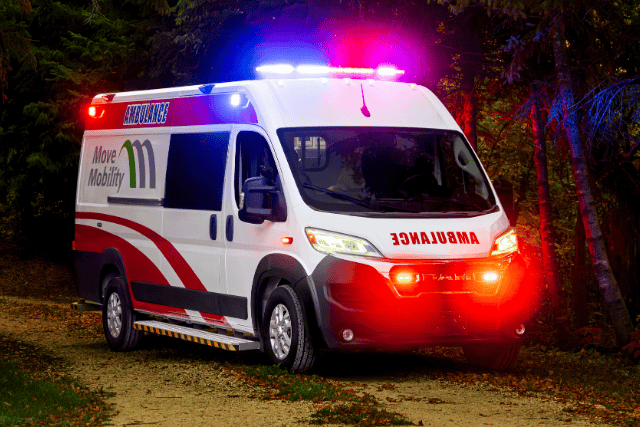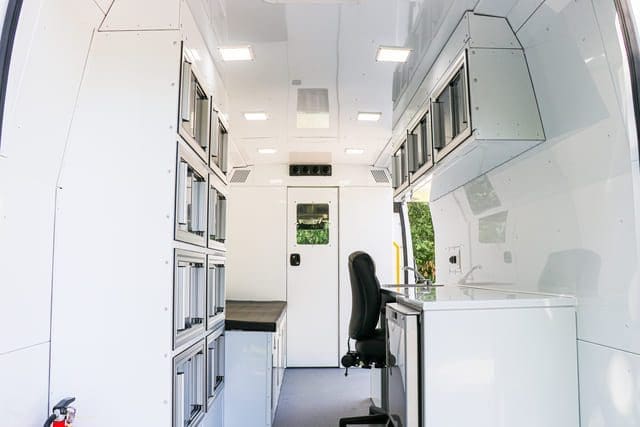Did you know that over 6 million Canadians avoid the dental care every year because of cost, distance, or lack of access to care? Statistics Canada shows how serious this gap is.
If you’re a dental hygienist or a dental organization, you know the frustration. People in rural and remote areas can’t always get to a clinic. The longer this goes on, the more oral health declines. At the same time, your practice misses the chance to grow and serve more people.
Now picture the other side. You roll into a community in a mobile dental hygiene clinic, ready to treat patients who haven’t had care in years. You’re meeting people where they are, improving health, and building trust.
I’m Andrew Burrowes, an Account Executive with MoveMobility. For over 20 years, we’ve been building vehicles that remove barriers to healthcare in Canada. My curiosity for remote areas and my background in sales and van outfitting help me understand what works where. We’ve worked with organizations from coast to coast, and while we’re not the only manufacturer, we’ve seen how the right vehicle changes lives.
In this article, I’ll walk you through 10 steps to starting a mobile dental hygiene clinic in Canada so you can:
- Understand your market
- Choose the right vehicle
- Meet regulations
- Launch with confidence
What are the 10 steps to starting a mobile dental hygiene clinic?
Starting a mobile dental hygiene clinic in Canada might feel like a huge project, but it’s really just a series of smaller steps stacked in the right order. Each one gets you closer to opening the doors (or in this case, the van doors) and seeing your first patients.
In this section, I’ll walk you through each step from figuring out your market to rolling out your services.
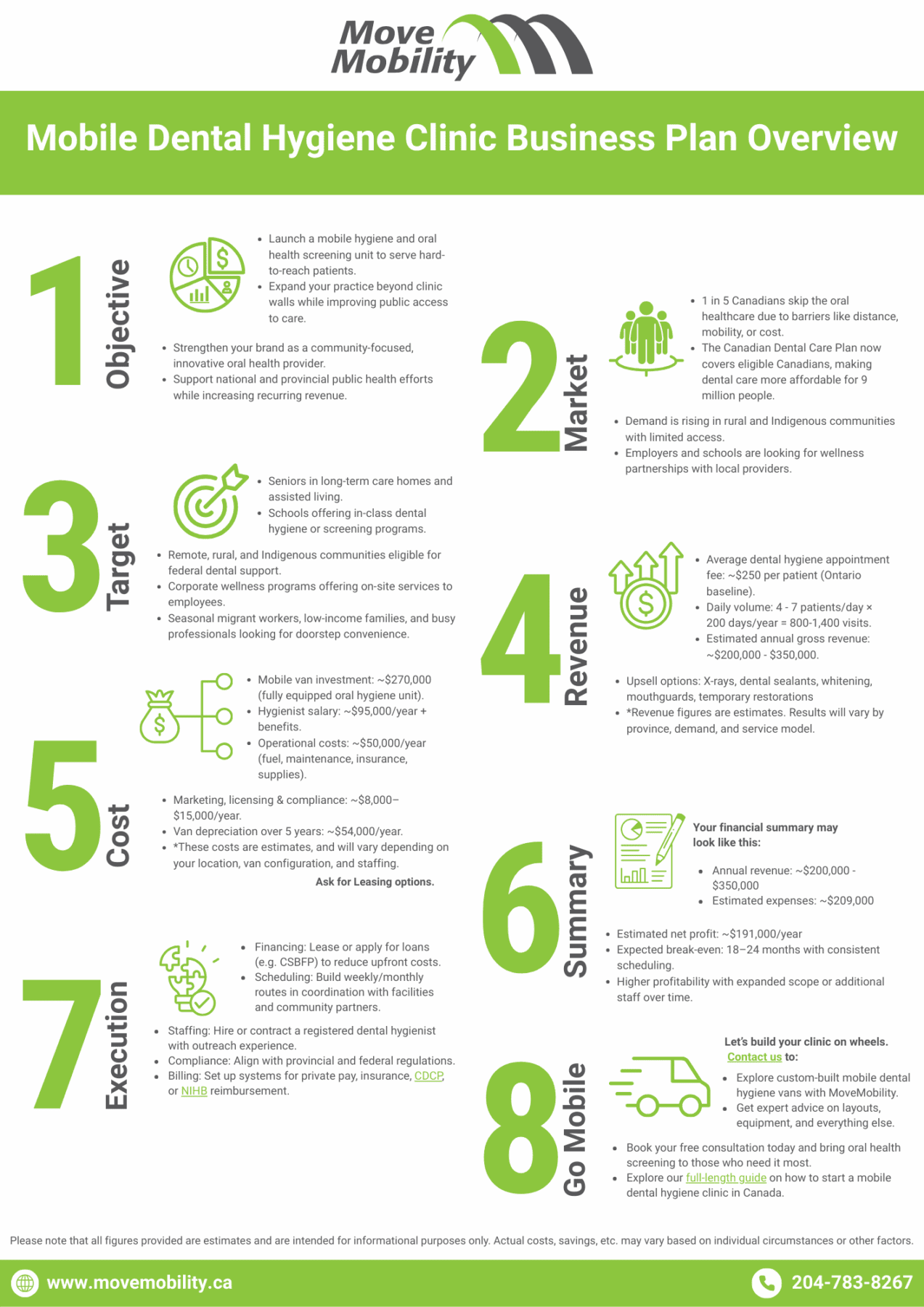
Step 1: Understand your market before starting a mobile dental hygiene clinic
Before you even think about buying a mobile dental hygiene van or equipment, you need to know who you’re serving and why. Without that, you’re guessing, and guessing can get expensive.
Start by asking yourself:
- Where’s the need? Many rural communities in provinces like Saskatchewan, Manitoba, and northern Ontario lack regular dental services. But don’t stop there, think about seasonal migrant farm workers, vulnerable groups in urban areas like low-income neighborhoods or recent immigrant families, and even busy or wealthy folks who want the convenience of dental care right at their doorstep.
- Who’s your target group? Are you focusing on schools, seniors, Indigenous communities, or these other groups? Each needs different care and schedules.
- What’s their current access? Are they lacking preventive care, urgent treatments, or both? CDHA data shows that only about 5% of Canada’s 34,000 dental hygienists operate independently, and roughly 35% run mobile practices, so there’s room to meet unmet needs in many markets.
You can find useful data from places like the Canadian Dental Hygienists Association or your province’s public health reports. Talking to local health authorities or community leaders can also uncover needs you might miss.
Knowing your market shapes everything, from the type of van you choose to the routes you plan. When organizations skip this step, they often end up with equipment or layouts that don’t match their real-world needs. That’s a mistake we want to avoid.
Step 2: Write a business plan for your mobile dental hygiene clinic
Before you start looking at mobile dental hygiene vans, you need a clear business plan. Skipping this step is like driving across Canada without a map. You might get somewhere, but probably not where you wanted to be. A good plan keeps you focused, helps you budget realistically, and makes lenders or grant reviewers take you seriously.
Core questions to answer:
- What services will you offer? Preventive cleanings, fluoride treatments, oral cancer checks, sealants, mouthguards, x-rays, whitening, or community events. The new Canadian Dental Care Plan (CDCP) is making oral care available to more than 9 million Canadians. This means more chances for independent hygienists to reach people who have never had regular care before.
- Who will pay? Public health contracts, private insurance, schools, charities, or direct-pay clients. Some busy or higher-income families may pay for care at their doorstep.
- How many patients will you see each day? Many mobile operators say a realistic goal is 3 to 8 visits per day. Travel time and appointment length will affect your number.
Estimate your costs:
- Startup cost: Most fully equipped mobile dental hygiene clinics in Canada cost between $250,000 and $300,000.
- Vehicle cost: Includes the base van, conversion, and dental equipment.
- Customization: Wheelchair lifts, graphics, off-road climate control for cold areas, and sterilization space will add to your costs.
- Portable gear: Many hygienists buy their own portable dental unit and chair so they can treat patients in homes or long-term care facilities. You can store these in the van when not in use. You will also need your own sterilizer, unless you return to a home base for cleaning, and all your instruments and cassettes.
What to put in the plan:
- Market summary: Who you serve and why they need your service.
- Services and prices: A simple fee table and contract rates.
- Staffing plan: Your schedule, driver needs, and admin support.
- Capital budget: Van, dental chair, compressor, sterilizer, portable gear, and supplies.
- Operating budget: Fuel, maintenance, insurance, supplies, and marketing.
- Funding sources: Federal and provincial grants, private foundations, and programs linked to the CDCP.
Think of your business plan as a living document. Markets shift, and so will your routes, pricing, and services. The stronger your plan, the easier it will be to adjust without losing momentum or overspending.
Tip: Keep it short and easy to understand. Decision-makers want clear numbers, realistic goals, and a plan you can follow.
Step 3: Secure funding for your mobile dental hygiene clinic
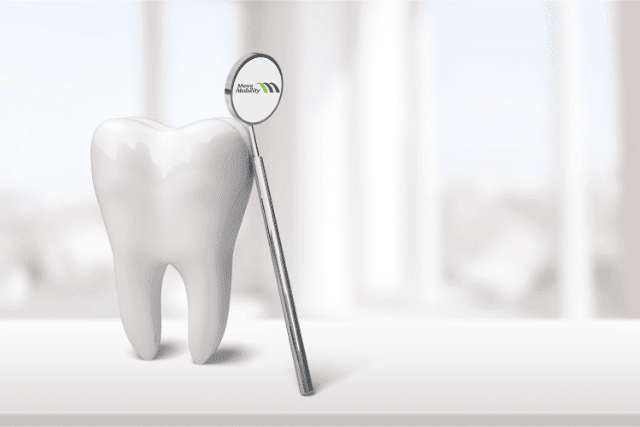
After your business plan is ready, the next step is finding money to pay for your mobile dental hygiene clinic. This can feel tricky, but Canada has many funding options you might not know about.
Here are some ways to get funding:
- Government grants: Health Canada and provincial health departments offer grants to help bring dental care to remote or low-income areas. You can check programs like Canada’s Health Grants.
- Charity and nonprofit support: The Canadian Dental Hygienists Association or your provincial hygienists’ association may know about grants you can apply for. They can also give you advice and guidance when you are getting started. Community foundations or dental associations may also offer money, supplies, or equipment.
- Bank loans: Banks and credit unions often give small business loans, including for healthcare clinics. A strong business plan makes it easier to get approved.
- Partnerships: You can team up with schools, seniors’ centers, or local governments to share costs and serve their communities.Make partnerships with local dentists and orthodontists so they can send patients your way.
When you apply for money, funders want details. Show them your budget, including the cost of your mobile dental hygiene van and the important mobile dental hygiene equipment like chairs and sterilizers.
Try making two budgets: One for the best setup and one simpler plan. This helps if you only get part of the money you ask for.
Clinics that sort out some funding before looking for a mobile dental hygiene van for sale usually do better. You’ll know what you can afford and can make smart choices.
Step 4: Choose the right mobile dental hygiene van and equipment
Now that your funding is lined up, it’s time to pick the mobile dental hygiene van and the gear you’ll need inside. These two go hand in hand because the size and layout of your van affect what equipment fits and how you work.
Choosing the van:
- Size and layout: If you plan to work alone, a smaller van might do. But if you want room for two hygienists or extra gear, go bigger.
- Accessibility: If you serve patients with disabilities, you might treat them in their homes or care facilities instead of having them enter the van.
- Climate control: Good insulation and heating keep patients and equipment safe, especially in colder parts of Canada.
- Reliability: A strong chassis means fewer breakdowns, which matters when you’re far from repair shops.
Picking the equipment:
- A dental chair that fits comfortably but doesn’t crowd the space
- Portable compressor and suction system that works quietly and efficiently
- Compact sterilization equipment like Statim that meets health rules and does not usually require a separate room inside the vehicle.
- Hand-held X-ray devices, if your scope of practice allows you to do radiography in your province.
- Portable personal tools like loupes and headlights, which can replace fixed chair lights and reduce power needs inside the van.
Tip: Visit other mobile dental hygiene clinics or ask your manufacturer for detailed floor plans before choosing. Seeing how others set up their vans helps you avoid surprises and make smarter space choices.
Step 5: Understand and meet provincial regulations for your mobile dental hygiene clinic
Canada’s healthcare rules can feel like a maze, especially when you’re running a mobile dental hygiene clinic that travels between communities. Each province has its own rules for licensing, safety, and infection control.
The first thing I tell people is to get familiar with the dental hygiene regulatory body in the province where you’ll operate. For example, Ontario has the College of Dental Hygienists of Ontario, while Alberta has the Alberta Dental Hygienists’ Association. These groups set the standards for how dental hygienists must work, including in mobile settings.
You’ll need to:
- Register your mobile clinic with the right health authorities
- Follow infection prevention rules just like a regular dental office
- Make sure your mobile dental hygiene van meets health and safety codes, including proper waste disposal and sterilization procedures
- Get any necessary permits for operating a vehicle as a healthcare unit
These rules can seem overwhelming, but they’re there to keep patients and staff safe. Missing a step could mean fines or shutting down your clinic.
Tip: Reach out early to provincial regulators. They can answer questions and might even offer checklists to keep you on track.
Dental hygienists’ associations and regulatory bodies in Canada
| Province/Territory | Association / Regulatory Body |
| Alberta | College of Registered Dental Hygienists of Alberta (CRDHA) |
| British Columbia | British Columbia College of Oral Health Professionals (BCCOHP) |
| Manitoba | College of Dental Hygienists of Manitoba (CDHM) |
| New Brunswick | New Brunswick College of Dental Hygienists (NBCDH) |
| Newfoundland and Labrador | Newfoundland and Labrador College of Dental Hygienists (NLCDH) |
| Nova Scotia | College of Dental Hygienists of Nova Scotia (CDHNS) |
| Ontario | College of Dental Hygienists of Ontario (CDHO) |
| Prince Edward Island | Dental Council of Prince Edward Island |
| Quebec | Ordre des hygiénistes dentaires du Québec (OHDQ) |
| Saskatchewan | Saskatchewan Dental Hygienists’ Association (SDHA) |
| Northwest Territories | Northwest Territories Dental Hygienists Association (NTDH) |
| Nunavut | Nunavut Dental Association |
| Yukon | Government of Yukon – Health and Social Services |
Step 6: Plan your routes and schedule for your mobile dental hygiene clinic
After you understand the rules and have your van and equipment set, it’s time to figure out where and when you’ll bring your mobile dental hygiene clinic to patients. Good route planning keeps your days efficient and helps you reach the people who need you most.
Start by mapping out the communities or facilities you want to serve. In Canada, rural areas in provinces like Manitoba or northern Ontario can be spread out, so travel time matters a lot.
Things to think about:
- Travel distances: Plan routes that minimize long back-and-forth trips to save fuel and time.
- Appointment scheduling: Group visits by location or population, like schools, seniors’ homes, or houses with several family members. This way you can see more patients in one stop and avoid extra trips.
- Community connections: Plan stops at local events, schools, Indigenous communities, and outreach organizations. These can be great ways to reach people who may not otherwise get care.
- Weather and road conditions: Keep an eye on seasonal challenges, especially in the winter months.
Use digital tools or apps to help with route planning. Some clinics use simple map apps, while others invest in specialized software to optimize stops and track visits.
Tip: Build in extra time for unexpected delays. In remote areas, a flat tire or road closure can throw off your whole day. Being flexible helps keep patients happy and your schedule on track.
Step 7: Hire and train your team for the mobile dental hygiene clinic
Now that your routes are planned, it’s time to build your team. Having the right people makes a huge difference in how smoothly your mobile dental hygiene clinic runs and how patients feel during their visit.
You’ll need skilled dental hygienists who are comfortable working in a mobile setting. This can be different from a regular clinic because of space limits and changing locations. Drivers who know the routes and can handle the van safely are just as important. Plus, someone to handle scheduling, paperwork, and patient communication rounds out the team.
Training is key. Make sure everyone knows the infection control rules and how to use the mobile dental hygiene equipment properly. It helps to run through emergency procedures and basic vehicle safety, too.
What to look for in your team:
- Flexibility and problem-solving skills for unexpected challenges on the road
- Friendly, patient-focused attitudes — mobile clinics often serve people who might be nervous or underserved
- Good communication to explain procedures clearly in different community settings
Tip: Start small and grow your team as demand grows. Many clinics begin with one or two hygienists and expand when they’re ready. This keeps costs manageable and lets you build a strong culture from day one. You can also use apps like Fairly Staffing to find hygienists interested in temporary work.
Step 8: Market your mobile dental hygiene clinic to reach your target community
You’ve got your van, team, and routes ready. Now, you need to tell people your mobile dental hygiene clinic is coming. Good marketing helps fill your schedule and builds trust in the communities you serve.
Reach out to local groups like schools, seniors’ centers, health clinics, and community programs. Work with friendly dentists who can send you patients who cannot get to their clinic. You can also send patients to them for services you do not offer. In northern and rural areas, First Nations community centers, band offices, and outreach groups can help spread the word. They might share your flyers or invite you to events.
Use flyers, social media, local radio, and newspapers to tell people about your clinic. A strong look for your van helps, too. Add your logo or wrap the whole van so it acts like a moving billboard. Share photos of your van, your team, and your work to help people feel welcome.
Ask happy patients to share their stories. Positive word of mouth matters a lot in smaller or remote communities.
Tip: Focus your message on removing barriers like long travel times or a lack of local care. For example, say, “Bringing dental care right to your doorstep in northern communities.” People respond well when they see you’re making care easier and closer to home.
Step 9: Manage your mobile dental hygiene clinic operations daily
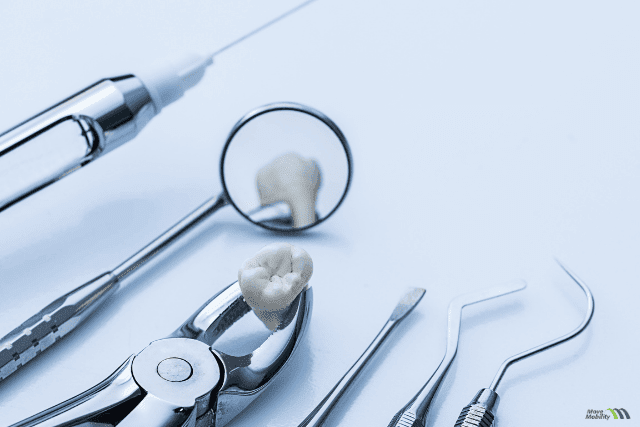
Running a mobile dental hygiene clinic means juggling patient care, vehicle upkeep, and staff schedules, all while on the move. Keeping things organized every day helps your clinic run smoothly and keeps patients happy.
Here’s what I recommend including in your daily routine:
- Check and prep your mobile dental hygiene equipment before appointments
- Inspect your mobile dental hygiene van for any maintenance issues or warning lights
- Confirm your route and appointments to avoid missed visits
- Make sure all supplies are ready, including gloves, cleaning tools, and enough sterile cassettes for the whole day.
For staying organized, apps like Google Calendar help manage appointments and staff schedules. For vehicle maintenance, tools like Fleetio let you track service history and get alerts for upcoming repairs. These tools save time and help prevent unexpected breakdowns.
Keep detailed patient records and vehicle logs. This helps with safety, billing, and improving your services over time.
Tip: Build a daily checklist your whole team follows. It keeps everyone on the same page and makes running your clinic less stressful.
Step 10: Evaluate and improve your mobile dental hygiene clinic regularly
Once your mobile dental hygiene clinic is up and running, don’t just set it and forget it. Regularly checking how things are going helps you spot problems early and find ways to do better.
Start by asking yourself questions like:
- Are you reaching enough patients in the communities you serve?
- Is your mobile dental hygiene van reliable and comfortable for patients and staff?
- Are your appointments booked efficiently, or do you have too many gaps?
- Is your team happy and well-trained?
Collect feedback from patients and your team. Simple surveys or quick chats can reveal what’s working and what needs fixing.
Look at your numbers too, such as patient visits, costs, and any downtime. This helps you make smart decisions on routes, schedules, or equipment upgrades.
Tip: Schedule regular check-ins every few months to review your clinic’s progress. Small changes over time can lead to big improvements and better care for your patients.
Bonus step: Invest in ongoing staff training and community education
A great way to keep your mobile dental hygiene clinic thriving is to focus on your team’s skills and educating the community you serve. Mobile clinics face unique challenges, so ongoing training helps your staff stay confident and ready for anything on the road.
Train your team on the latest dental hygiene techniques, how to work well in different community settings, cultural sensitivities, and emergency procedures. This makes your clinic more adaptable and trustworthy.
At the same time, educate your communities about oral health. Partner with local schools, community centers, or Indigenous groups to run workshops, hand out easy-to-understand materials, or host fun events. This builds trust and helps people care for their teeth before problems get worse.
Why is ongoing training important?
- Trained staff provide better care, making patients feel safe and comfortable
- Community education lowers the number of emergency dental visits
- Strong local relationships open doors for funding and support
Tip: Schedule regular training sessions and community events. Keeping your team sharp and your clinic visible helps you grow steadily and make a real difference.
Got any questions about starting a mobile dental hygiene clinic?
You’re here because you want to start a mobile dental hygiene clinic in Canada. Maybe you’re worried about how to reach rural locations, choosing the right vehicle, or figuring out all the regulations. This article helped you see how to fix those problems and bring dental care right to the people who need it.
Here’s what you learned after reading:
- How to plan and pay for your mobile dental hygiene clinic
- Picking the right van and dental equipment
- Understanding the rules and planning your routes
- Building your team, telling people about your clinic, and running things every day
- Tips to keep getting better and helping more people
At MoveMobility, we’ve been helping folks like you for over two decades. From busy cities to remote towns, we build vans that break down barriers and save lives. We’re proud to be your trusted manufacturer, making sure your mobile dental hygiene clinic works well and reaches those who need it most. We know we’re not the only ones out there, but we work hard to be one of the best.
If you want to talk more or have questions, click the button below to chat with me.
Not ready yet? No worries. Check out these articles to learn more:
Start by checking out our article on mobile medical van service. This is a question some customers ask if they have an issue with their future vehicle.
At this point, you might also be curious about warranties. Check out our article on that to learn more.


